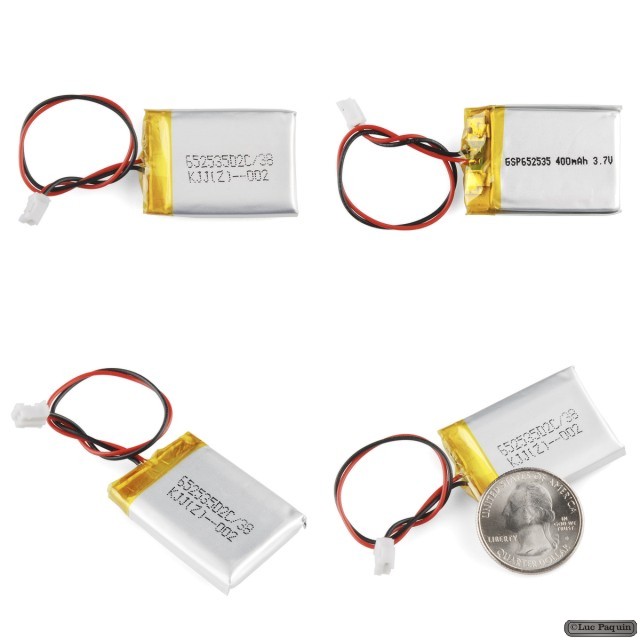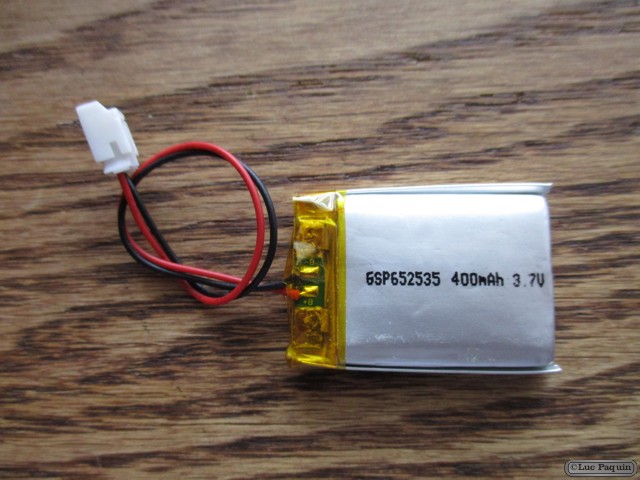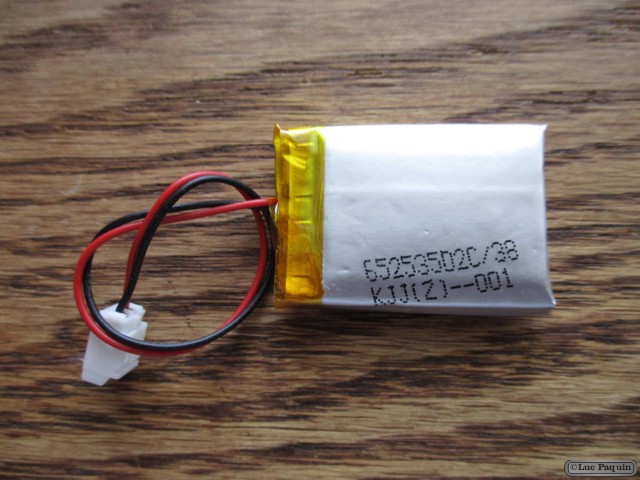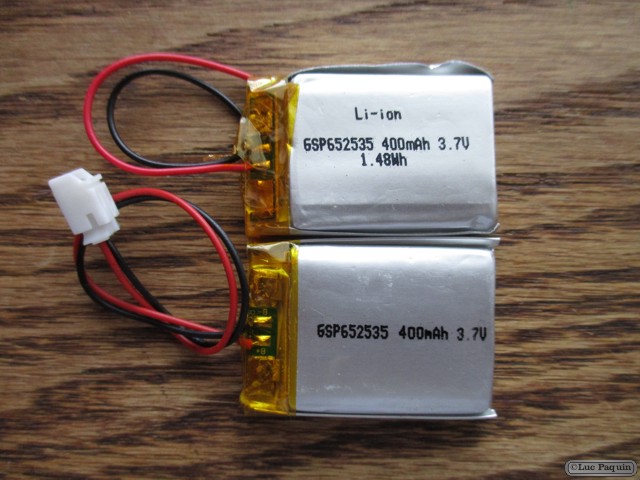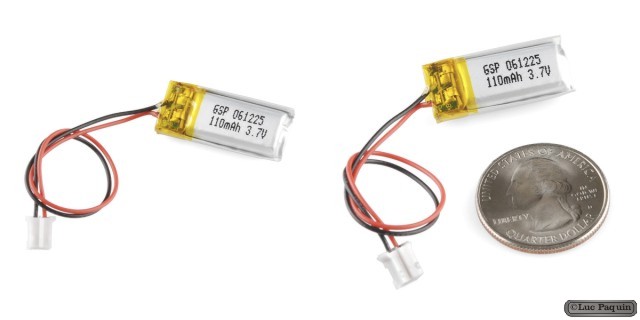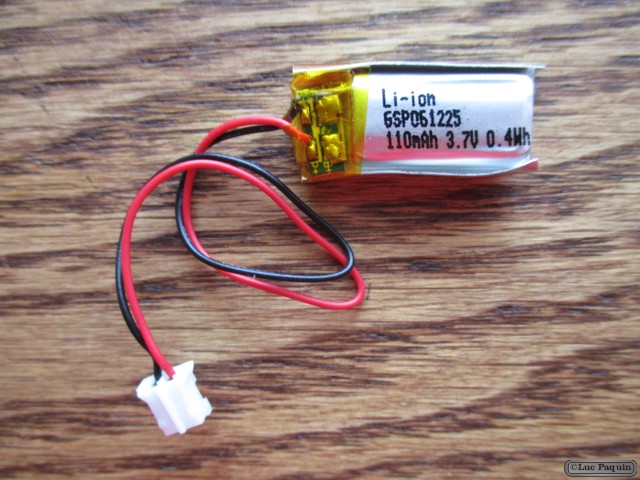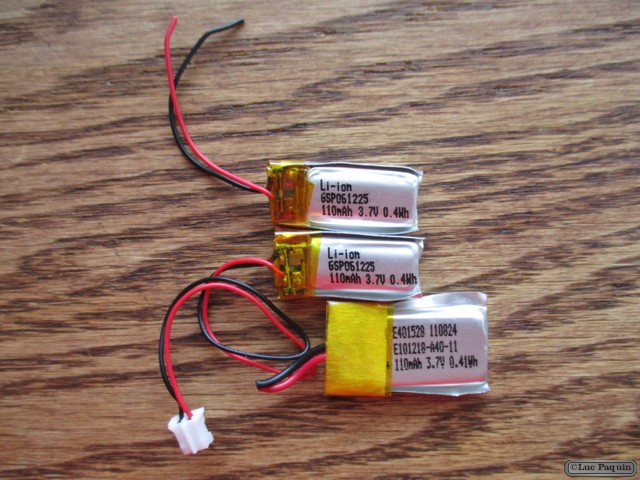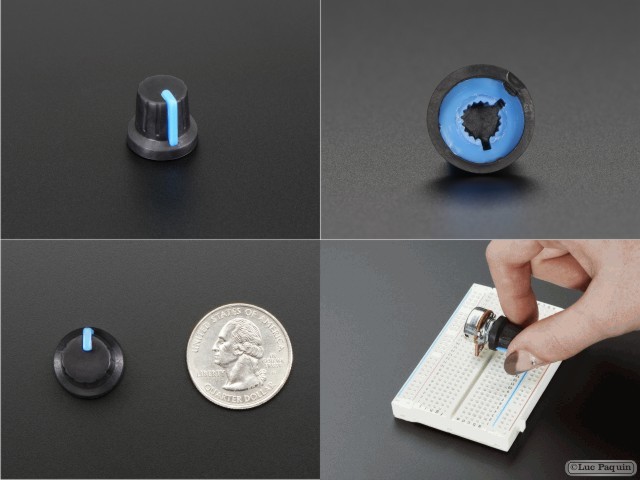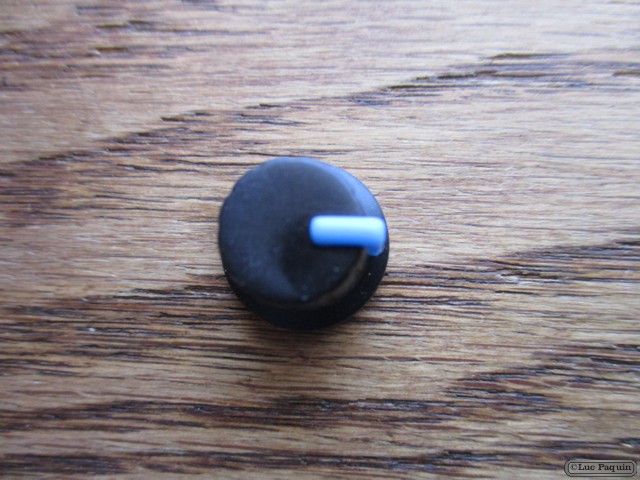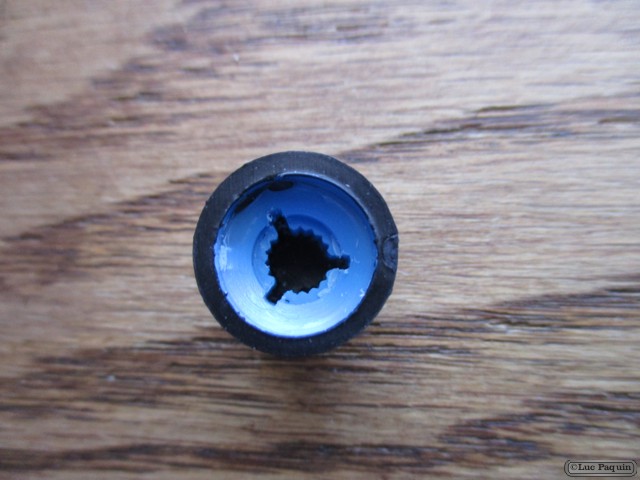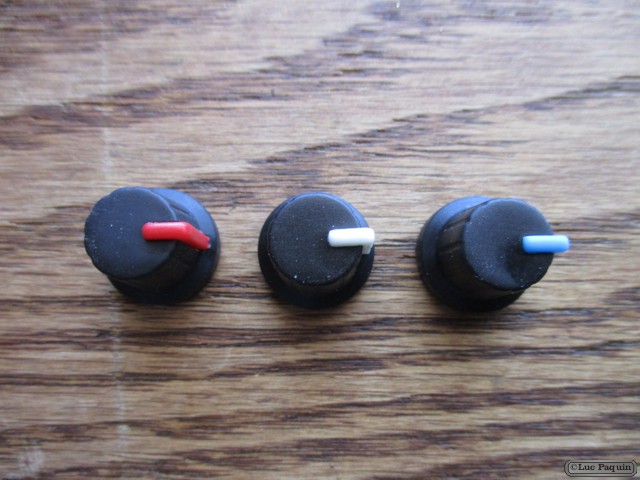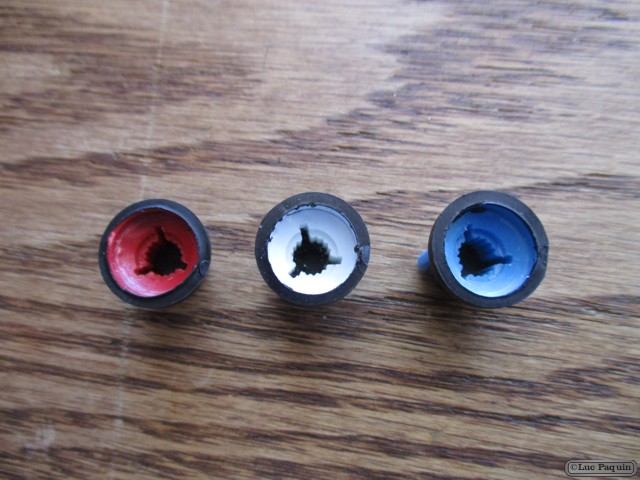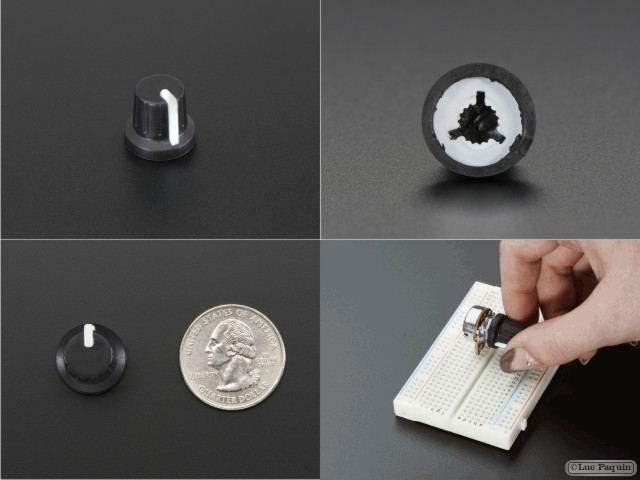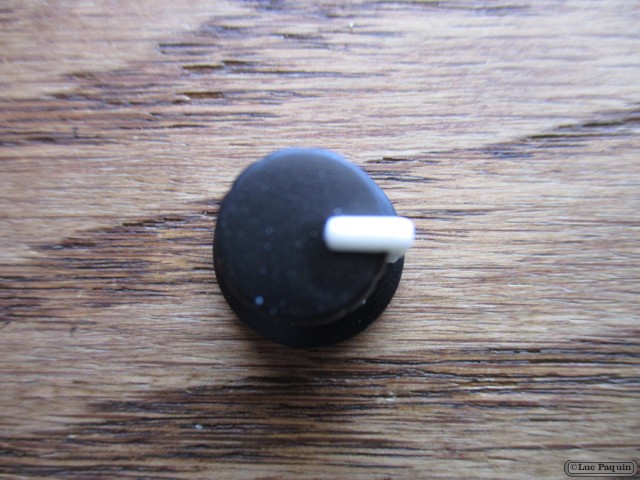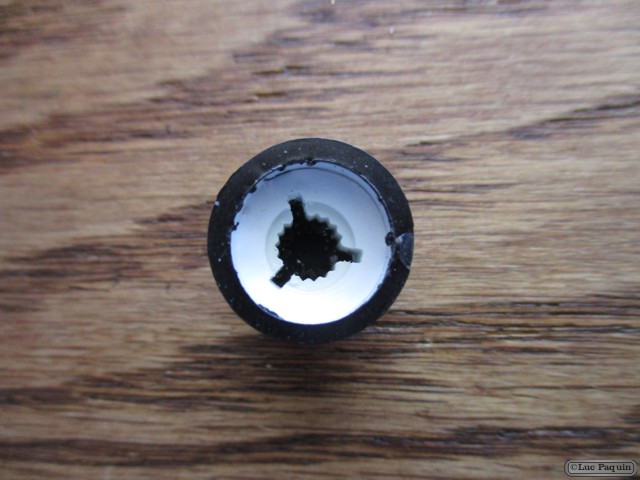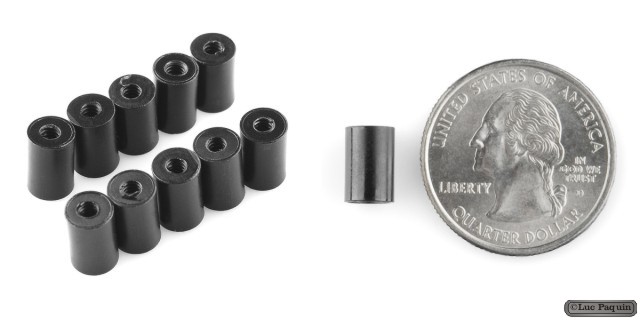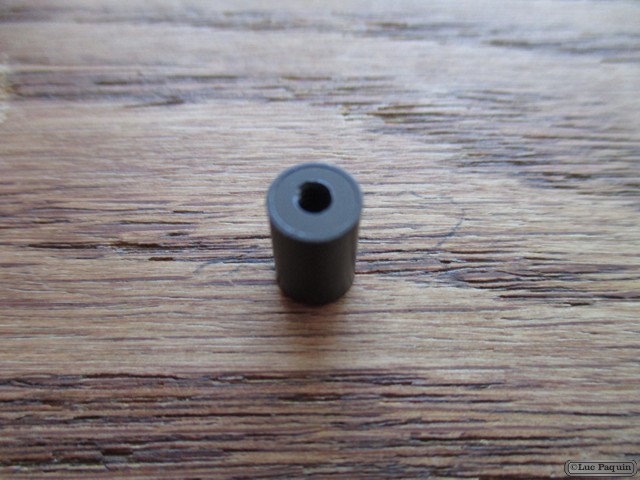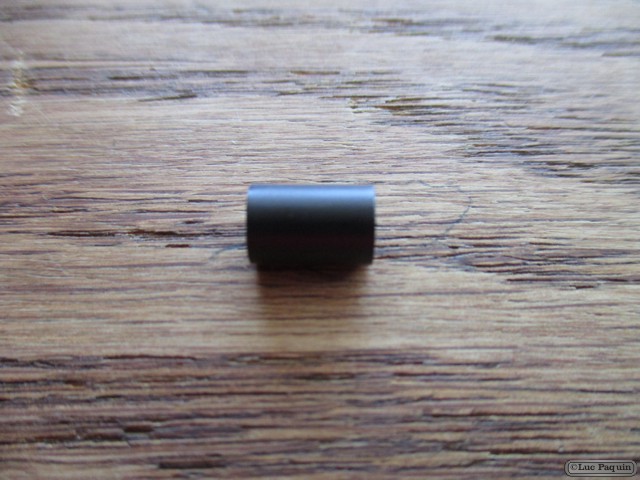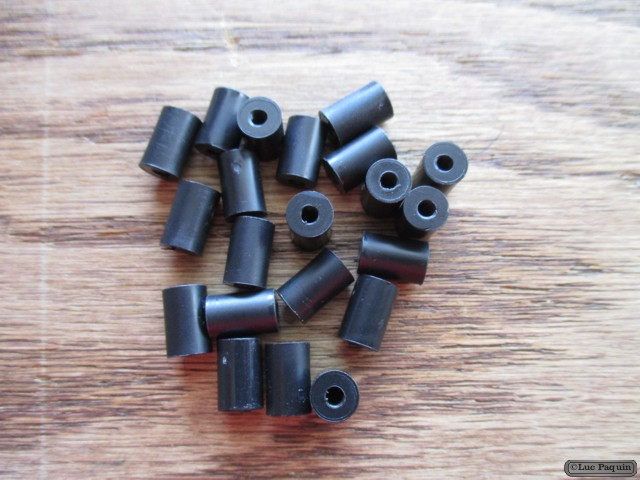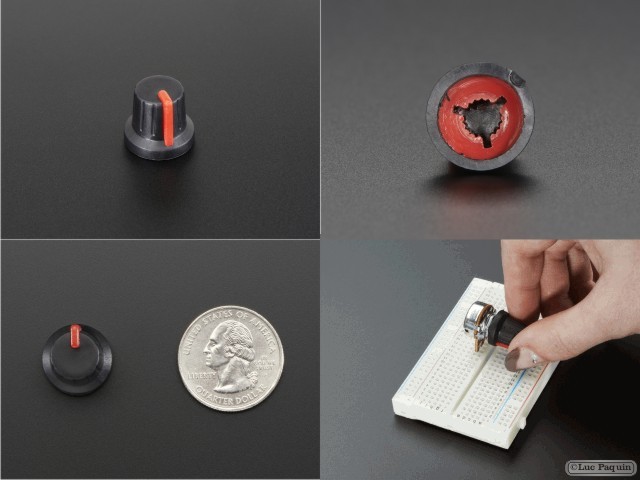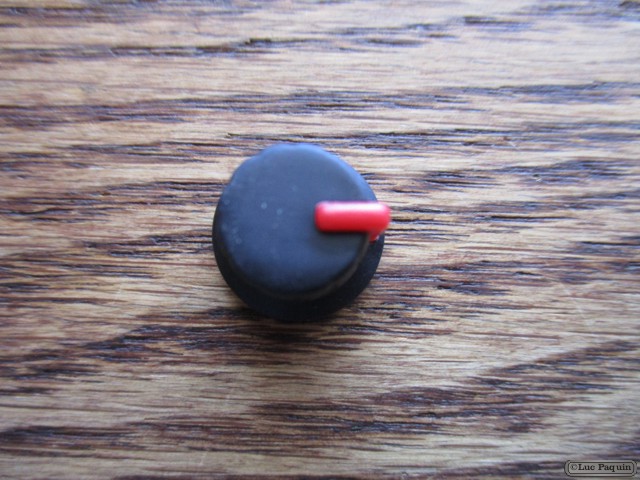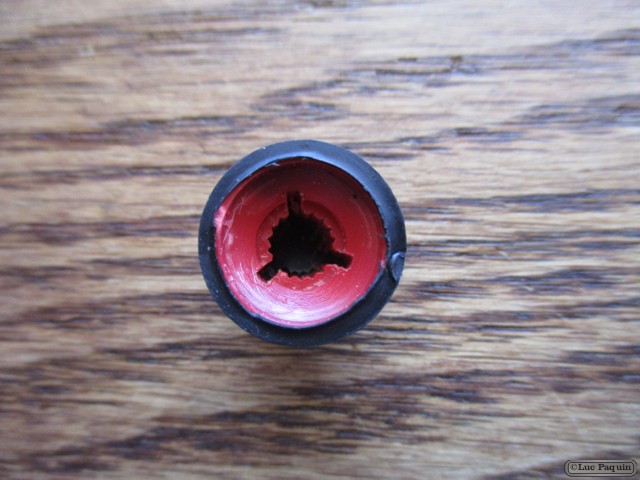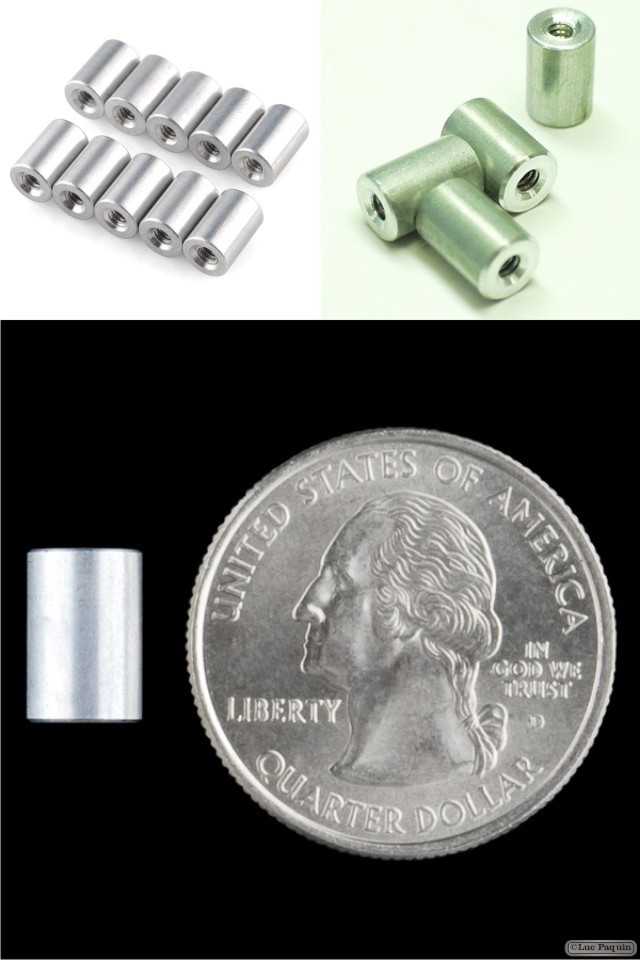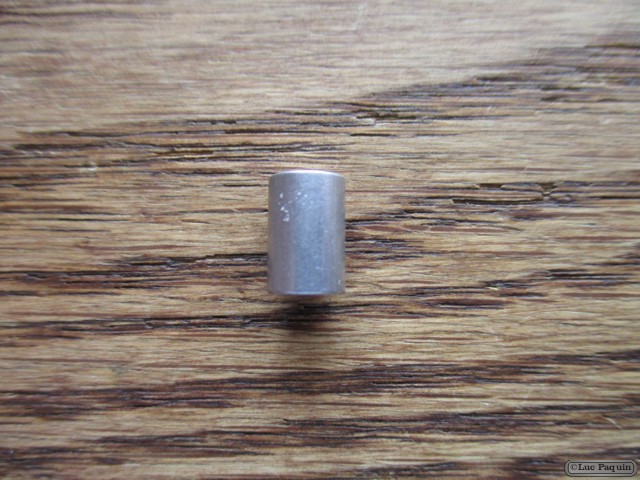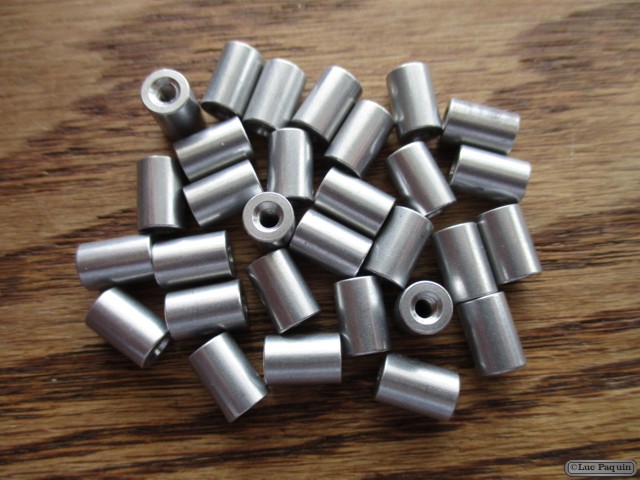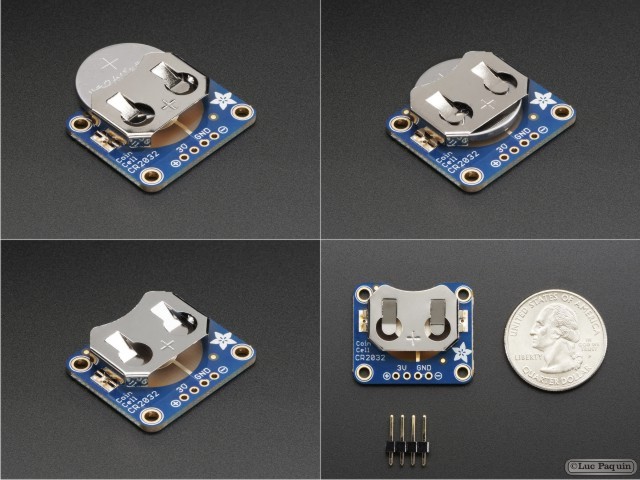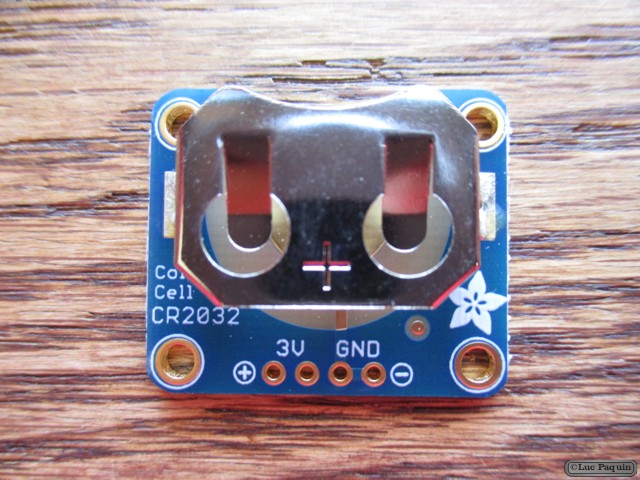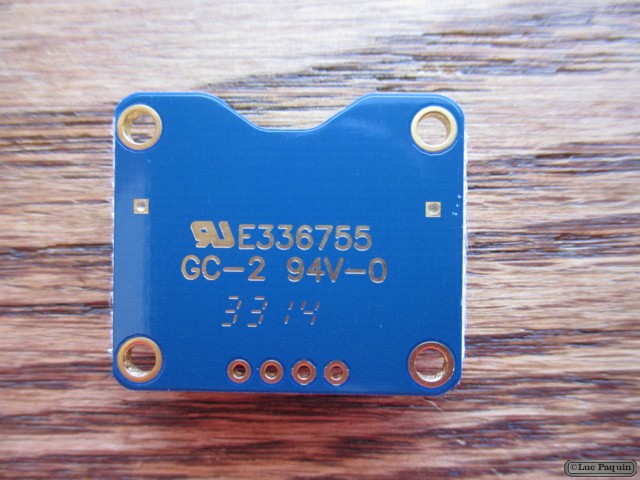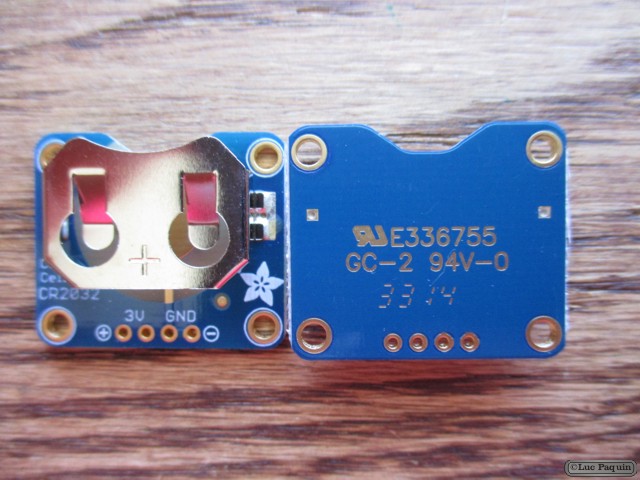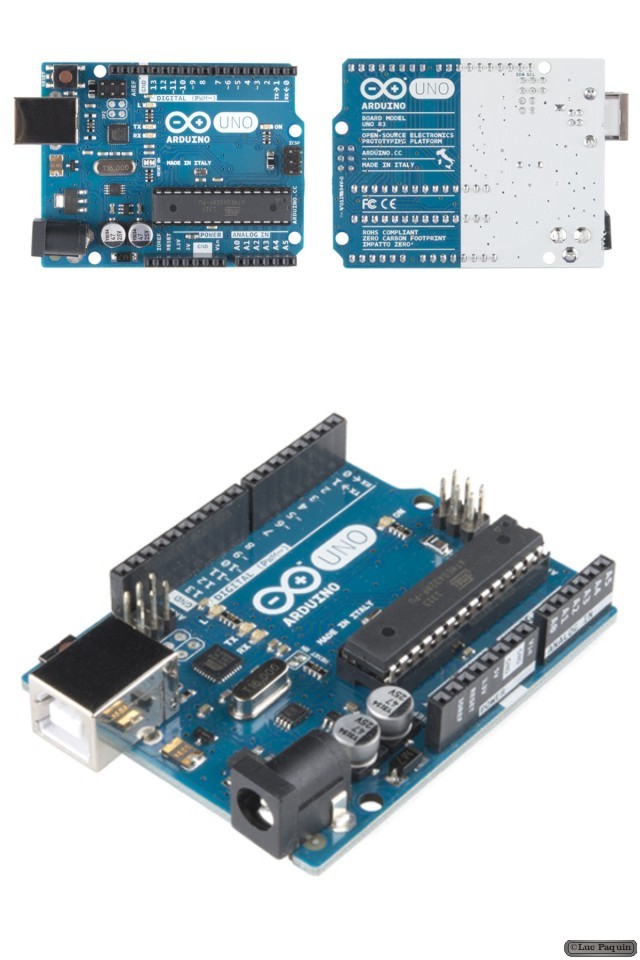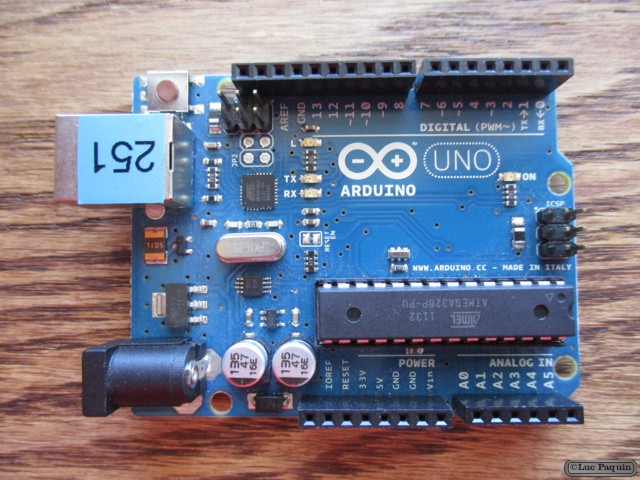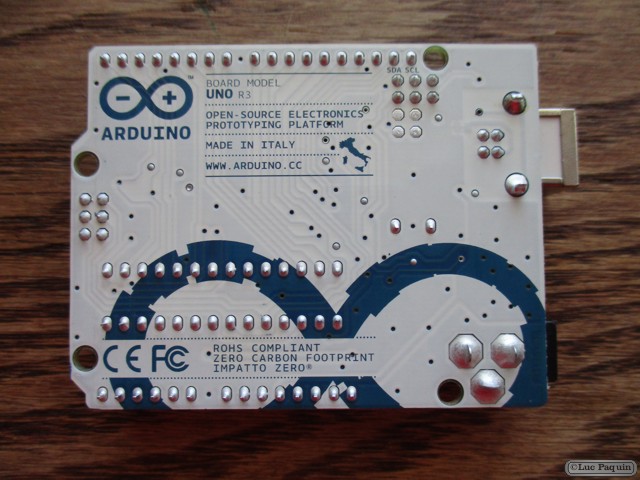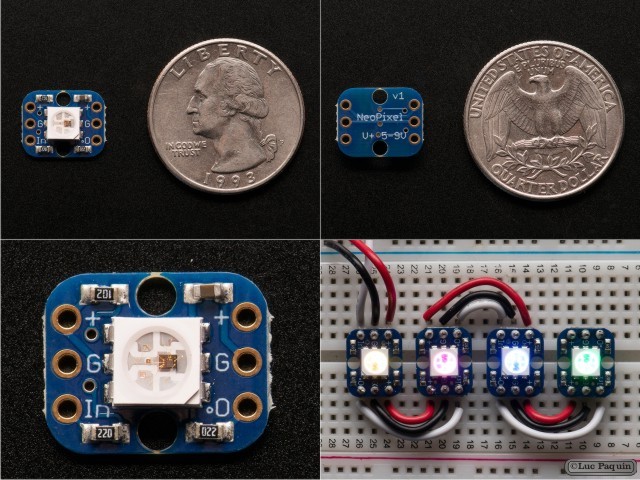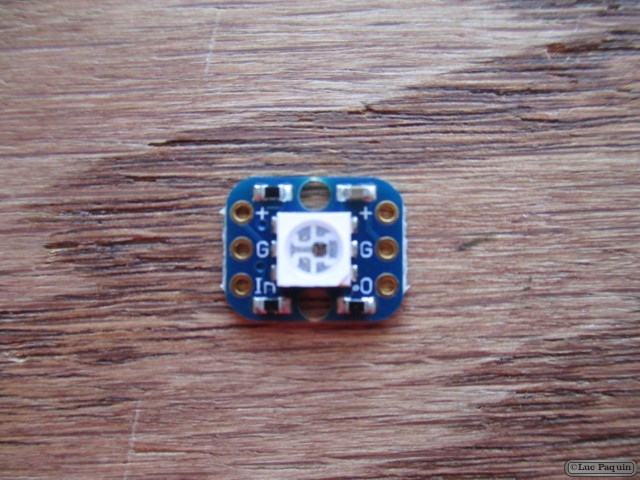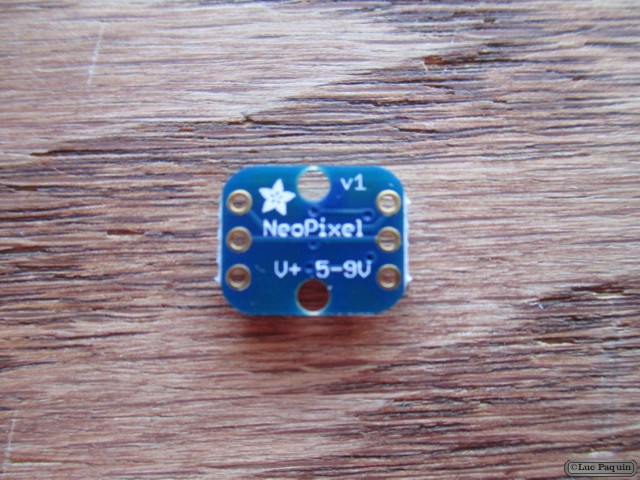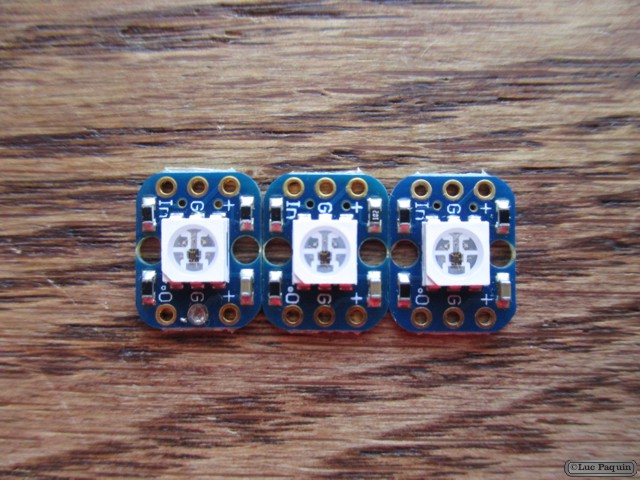#02 – Glasses LED
SparkFun – Polymer Lithium Ion Battery – 400mAh
SparkFun: PRT-10718
Description: This is a very small, extremely light weight battery based on the new Polymer Lithium Ion chemistry. This is the highest energy density currently in production. Each cells outputs a nominal 3.7V at 400mAh! Comes terminated with a standard 2-pin JST-PH connector – 2mm spacing between pins. These batteries require special charging. Do not attempt to charge these with anything but a specialized Lithium Polymer charger.
Battery includes built-in protection against over voltage, over current, and minimum voltage. Please use caution when using this battery in wearable projects. When using conductive thread, a short in the thread can create sparks and heat. We recommend using coin cell batteries for beginners.
Note: Be careful with the JST connectors. They can stick in pretty good and tugging on them can damage the connector.
Dimensions: 5x25x35mm
Weight: 9g
Features:
- 2C continuous discharge – very high for low price
- Excellent long-term self-discharge rates (<8% per month)
- Robust power source under extreme conditions (-25 to 60C)
Don Luc
SparkFun – Polymer Lithium Ion Battery – 110mAh
SparkFun: PRT-00731
Description: This is a very small, extremely light weight battery based on the new Polymer Lithium Ion chemistry. This is the highest energy density currently in production. Each cells outputs a nominal 3.7V at 110mAh! Comes terminated with a standard 2-pin JST-PH connector – 2mm spacing between pins. These batteries require special charging. Do not attempt to charge these with anything but a specialized Lithium Polymer charger.
Battery includes built-in protection against over voltage, over current, and minimum voltage. Please use caution when using this battery in wearable projects. When using conductive thread, a short in the thread can create sparks and heat. We recommend using coin cell batteries for beginners.
Note: Be careful with the JST connectors. They can stick in pretty good and tugging on them can damage the connector.
Dimensions: 5.7x12x28mm
Weight: 2.65g
Features:
- Excellent long-term self-discharge rates (<8% per month)
- Robust power source under extreme conditions (-25 to 60C)
Don Luc
Adafruit – Potentiometer Knob – Soft Touch T18 – Blue
Adafruit: 2048
Description
Oh say can you see
By the knob’s early light…
Sorry – we thought that was clever. And while it wasn’t really, this potentiometer knob definitely is. It’s a ‘soft touch’ T18 knob that works great with our Panel Mount 10K, Panel Mount 1K, and Panel Mount 100K potentiometers. The knob is designed to set directly on the potentiometer’s ridges so it’s an easy & secure fit. It has a nice feel, with a rubbery grip, tweaking it is quite fulfilling.
This is the blue version and it has a nice deep color on the inside with a striking blue line on the outside for great visibility with whatever you’re making. We also carry it in white and red if you’re looking for a variety of colors.
Technical Details
- Diameter of the top: 11mm / 0.4″
- Diameter of the base: 15mm / 0.6″
- Weight: 1g
- Colour: Blue
Don Luc
Adafruit – Potentiometer Knob – Soft Touch T18 – White
Adafruit: 2047
Description
Oh say can you see
By the knob’s early light…
Sorry – we thought that was clever. And while it wasn’t really, this potentiometer knob definitely is. It’s a ‘soft touch’ T18 knob that works great with our Panel Mount 10K, Panel Mount 1K, and Panel Mount 100K potentiometers. The knob is designed to set directly on the potentiometer’s ridges so it’s an easy & secure fit. It has a nice feel, with a rubbery grip, tweaking it is quite fulfilling.
This is the blue version and it has a nice deep color on the inside with a striking blue line on the outside for great visibility with whatever you’re making. We also carry it in white and red if you’re looking for a variety of colors.
Technical Details
- Diameter of the top: 11mm / 0.4″
- Diameter of the base: 15mm / 0.6″
- Weight: 1g
- Colour: White
Don Luc
SparkFun – Standoff – Nylon (4-40; 3/8″)
Adafruit – Potentiometer Knob – Soft Touch T18 – Red
Adafruit: 2046
Description
Oh say can you see
By the knob’s early light…
Sorry – we thought that was clever. And while it wasn’t really, this potentiometer knob definitely is. It’s a ‘soft touch’ T18 knob that works great with our Panel Mount 10K, Panel Mount 1K, and Panel Mount 100K potentiometers. The knob is designed to set directly on the potentiometer’s ridges so it’s an easy & secure fit. It has a nice feel, with a rubbery grip, tweaking it is quite fulfilling.
This is the blue version and it has a nice deep color on the inside with a striking blue line on the outside for great visibility with whatever you’re making. We also carry it in white and red if you’re looking for a variety of colors.
Technical Details
- Diameter of the top: 11mm / 0.4″
- Diameter of the base: 15mm / 0.6″
- Weight: 1g
- Colour: Red
Don Luc
SparkFun – Standoff – Metal (4-40; 3/8″; 10 pack)
Adafruit – 20mm Coin Cell Breakout Board (CR2032)
Adafruit: 1870
Description
Simple but effective – this breakout board has a CR2032 coin cell battery holder soldered on and 0.1″ pitch breakout pins for easy connecting. Great for powering very low-current projects, or adding a battery backup circuit to a real-time-clock or similar.
Comes with one fully assembled and tested coin cell battery holder and a small stick of 0.1″ header so you can solder it on and plug into a breadboard. Coin cell battery is not included.
Technical Details
Dimensions:
- 23.5mm x 28mm x 1.6mm / 0.9″ x 1.1″ x 0.06″
- Mounting hole distance: 18mm x 22mm / 0.7″ x 0.9″
- Weight: 3g
Don Luc
SparkFun – Arduino Uno – R3
SparkFun: DEV-11021
Description: This is the new Arduino Uno R3. In addition to all the features of the previous board, the Uno now uses an ATmega16U2 instead of the 8U2 found on the Uno (or the FTDI found on previous generations). This allows for faster transfer rates and more memory. No drivers needed for Linux or Mac (inf file for Windows is needed and included in the Arduino IDE), and the ability to have the Uno show up as a keyboard, mouse, joystick, etc.
The Uno R3 also adds SDA and SCL pins next to the AREF. In addition, there are two new pins placed near the RESET pin. One is the IOREF that allow the shields to adapt to the voltage provided from the board. The other is a not connected and is reserved for future purposes. The Uno R3 works with all existing shields but can adapt to new shields which use these additional pins.
Arduino is an open-source physical computing platform based on a simple i/o board and a development environment that implements the Processing/Wiring language. Arduino can be used to develop stand-alone interactive objects or can be connected to software on your computer (e.g. Flash, Processing, MaxMSP). The open-source IDE can be downloaded for free (currently for Mac OS X, Windows, and Linux).
Note: The Arduino Uno R3 requires the Arduino 1.0 drivers folder in order to install properly on some computers. We have tested and confirmed that the R3 can be programmed in older versions of the IDE. However, the first time using the R3 on a new computer, you will need to have Arduino 1.0 installed on that machine. If you are interested in reading more about the changes to the IDE, check out the official Arduino 1.0 Release notes!
Features:
- ATmega328 microcontroller
- Input voltage – 7-12V
- 14 Digital I/O Pins (6 PWM outputs)
- 6 Analog Inputs
- 32k Flash Memory
- 16Mhz Clock Speed
Don Luc
Adafruit – Breadboard-Friendly RGB Smart NeoPixel
Adafruit: 1312
Description
This is the easiest way possible to add small, bright RGB pixels to your project. We took the same technology from our Flora NeoPixels and made them breadboard friendly, with two rows of 3 x 0.1″ spaced header on each side for easy soldering, chaining and breadboarding. These ultra-bright LEDs have a constant-current driver cooked right into the LED package! The pixels are chainable – so you only need 1 pin/wire to control as many LEDs as you like.
These pixels have full 24-bit color ability with PWM taken care of by the controller chip. Since the LED is so bright, you need less current/power to get the effects you want. The driver is constant current so its OK if your battery power changes or fluctuates a little.
Each pixel draws as much as 60mA (all three RGB LEDs on for full brightness white). An Arduino can drive up to 500 pixels at 30 FPS (it will run out of RAM after that). Using ribbon cable you can string these up to 6″ apart (after that, you might get power droops and data corruption)
Each order comes with 4 individually controllable pixels. In the photos above we show the pixels with headers soldered on, but the pixels do not come with any headers.
Technical Details
- Dimensions: 0.4″ x 0.5″ x 0.1″ / 10.2mm x 12.7mm x 2.5mm
- 0.5″ (12.5mm) diameter circle PCB, 0.1″ (2.5mm) total thickness
- 800 KHz speed protocol
- Chainable design
- 5-9VDC power (can run at 3.5V but color will be dimmed), constant current 18.5mA per LED (~55mA max total per pixel)
Don Luc
